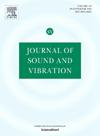A parametrized virtual point reduced estimation framework for determining an unknown force’s magnitude, direction and position of action
IF 4.3
2区 工程技术
Q1 ACOUSTICS
引用次数: 0
Abstract
This article challenges the question of whether a force applied to a rigid interface can be estimated jointly with its position and direction of action utilizing a model which does not take such a force explicitly into account. Firstly, we discuss linear model-based estimation as a possibility to determine the amplitude, direction and position of a given unknown force acting on a rigid interface. For this purpose, the estimation results of two linear augmented Kalman filters are considered. One configuration delivers estimates for a set of equivalent forces applied to a rigid interface, which are subsequently reduced to a virtual point. The other configuration considers inputs reduced into the virtual point of interest, estimating directly the forces and moments acting on it. After the estimation process, a nonlinear system of equations is solved to characterize an arbitrary unknown acting force in amplitude, position, and direction. Thereafter, this article proposes two novel approaches based on a nonlinear augmented state–space model defined by using the Virtual Point Transformation (VPT) method that incorporates the explicit position or the lever arms of the unknown applied force as well as its direction of action with respect to the considered virtual point as parameters to be estimated. An observability analysis for these nonlinear systems is provided utilizing recent results to determine the observability of nonlinear systems with direct feedthrough and based on Lie derivatives. It was found that only the latter formulation is fully observable and hence an Augmented Extended Kalman Filter (AEKF) parametrized via the lever arms between the unknown force and the considered virtual point is chosen. The proposed methodology is then experimentally validated on an automotive-grade rubber mount component. The results show a superior performance of the nonlinear estimation framework in the time- and frequency-domain over the linear counterparts. Moreover, the unknown position and direction at which the force is applied can be estimated with higher precision and without further processing using the AEKF framework.
一种用于确定未知力的大小、方向和位置的参数化虚点简化估计框架
本文提出了一个问题,即施加在刚性界面上的力是否可以利用一个没有明确考虑这种力的模型来估计其位置和作用方向。首先,我们讨论了基于线性模型的估计,作为确定作用在刚性界面上的给定未知力的幅度,方向和位置的可能性。为此,考虑了两种线性增广卡尔曼滤波器的估计结果。一种配置提供了施加在刚性界面上的一组等效力的估计,这些力随后被简化为一个虚拟点。另一种构型考虑将输入简化为虚拟感兴趣点,直接估计作用在其上的力和力矩。在估计过程之后,求解一个非线性方程组来表征任意未知的振幅、位置和方向的作用力。此后,本文提出了两种基于非线性增强状态空间模型的新方法,该模型使用虚拟点变换(VPT)方法定义,该方法将未知施加力的显式位置或杠杆臂及其相对于所考虑的虚拟点的作用方向作为待估计的参数。利用近年来的研究结果,对这些非线性系统的可观测性进行了分析,以确定直接馈通非线性系统的可观测性。发现只有后一种形式是完全可观察的,因此选择了通过未知力和所考虑的虚点之间的杠杆臂参数化的增广扩展卡尔曼滤波器(AEKF)。然后在汽车级橡胶安装部件上实验验证了所提出的方法。结果表明,非线性估计框架在时域和频域的性能优于线性估计框架。此外,可以使用AEKF框架以更高的精度估计施加力的未知位置和方向,而无需进一步处理。
本文章由计算机程序翻译,如有差异,请以英文原文为准。
求助全文
约1分钟内获得全文
求助全文
来源期刊

Journal of Sound and Vibration
工程技术-工程:机械
CiteScore
9.10
自引率
10.60%
发文量
551
审稿时长
69 days
期刊介绍:
The Journal of Sound and Vibration (JSV) is an independent journal devoted to the prompt publication of original papers, both theoretical and experimental, that provide new information on any aspect of sound or vibration. There is an emphasis on fundamental work that has potential for practical application.
JSV was founded and operates on the premise that the subject of sound and vibration requires a journal that publishes papers of a high technical standard across the various subdisciplines, thus facilitating awareness of techniques and discoveries in one area that may be applicable in others.
 求助内容:
求助内容: 应助结果提醒方式:
应助结果提醒方式:


